Larry Lawrence | August 13, 2019
Archives: Wood’s Good Machines
Ron Wood’s dreams must have been filled with ways to build racing motorcycles. How else could you explain the nearly inexhaustible mind that produced one innovative racing machine after the next?
Archives: Wood’s Good Machines
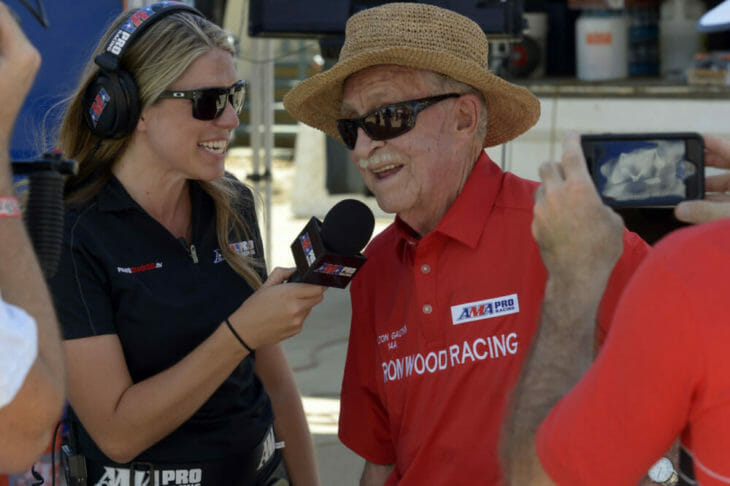 Ron Wood being interviewed after Dalton Gauthier raced the Wood BMW to victory at the Arizona Mile in 2016. (Courtesy American Flat Track)
Ron Wood being interviewed after Dalton Gauthier raced the Wood BMW to victory at the Arizona Mile in 2016. (Courtesy American Flat Track)
Wood, best known for his highly-successful Wood-Rotax flat track racer, passed away July 22 at his home in Newport Beach, California. He was 90. Wood had a lot of friends and admirers; you could tell by the outpouring of condolences on social media after Wood’s passing.
Wood was born in Pasadena, CA in 1928. When he was a teenager his family moved to Oregon, but at 20, Wood moved back to Southern California, according to his son Ron, to escape constant bouts of hay fever. By then Wood was already riding all over the west coast on his AJS, even using it at times as his daily driver.
As a young man Wood worked hard. Starting as a janitor at a lighting company, Wood eventually opened his own commercial lighting company – Wood Lighting Fixture Co. – and he became a successful entrepreneur employing over 100 people. The company made Wood well-off, and according to seven-time AMA Grand National Champion Chris Carr, inside the company’s 50,000 square foot building, there was a little hobby area that always put a smile on Ron’s face.
“He partitioned off a part of his company and ran his racing shop out of there,” Carr explained. “No doubt, I think he was happiest when he was working on the racing side of the building.”
Wood had become a fan of flat track racing by watching the Friday night races at Ascot Park in Gardena. Early on Wood began building Ducati short-track bikes. Those bikes were highly successful in regional West Coast flat-track racing, but Wood wanted to build bigger bikes for AMA Grand National competition. This was the 1970s, the height of flat track racing in America, and the competition was fierce. Harley-Davidson had a massive multi-rider factory team at that point and they supported other riders in the series as well. Yamaha was there too, as was Triumph and BSA, so simply being able to build bike that could qualify for a national was a major undertaking to say the least. Many had tried and failed.
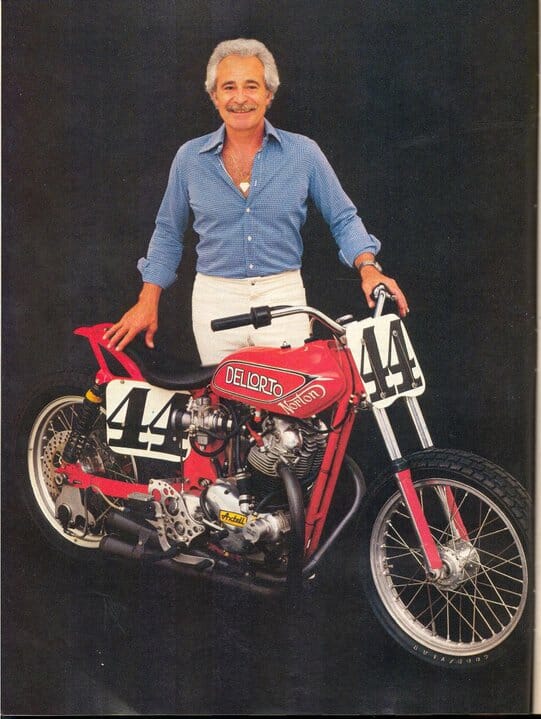 Ron Wood standing with the Norton “Lightweight” that Alex “Jorgy” Jorgensen used to win the Ascot AMA Grand National in May of 1978. It was the last national ever won by a Norton.
Ron Wood standing with the Norton “Lightweight” that Alex “Jorgy” Jorgensen used to win the Ascot AMA Grand National in May of 1978. It was the last national ever won by a Norton.
And Ron being Ron, didn’t want to go the established route. After all, he’d learned the ropes building Ducati short track bikes for goodness sakes. It wouldn’t be his style to simply do his take on a Harley or Yamaha flat tracker. No, Wood wanted something unique, so he went with Norton.
Why Norton? Wood revealed that answer to Cycle World magazine’s Steve Anderson in 1998.
“At first the XRs weren’t all that fast,” Wood told Anderson. “Back then, Triumphs and Yamahas were winning a lot of dirt tracks, and there was no dominant choice. The Norton seemed as good as anything.”
To start his Norton project in the early ‘70s, Wood bought a wrecked Commando for 200 bucks. His first Norton flat tracker was a unique creation with a one-piece tank/seat/tail section. At Ascot Eddie Mulder set fast qualifying time on the machine, so Wood knew he was on the right track. The hardest thing was keeping the high-strung Norton motor from blowing up. Wood’s white and powder blue-colored Norton was so eye-catching that it prompted Jody Nicholas to say, “The machine was so beautifully constructed, I almost felt guilty getting it dirty!”
Gradually Wood dialed a next generation design by the mid-1970s he called the “big-tube” Norton. The frame tubes doubled as the oil tank. While the frame, with its 3-inch diameter tubing, looked massive, the tubing itself was incredibly thin (.049-inch thickness) making the Norton incredibly light. The engine was mounted to the frame by way of beefy steel pads that protect the fragile frame by absorbing the pounding of the big vertical-twin engine.
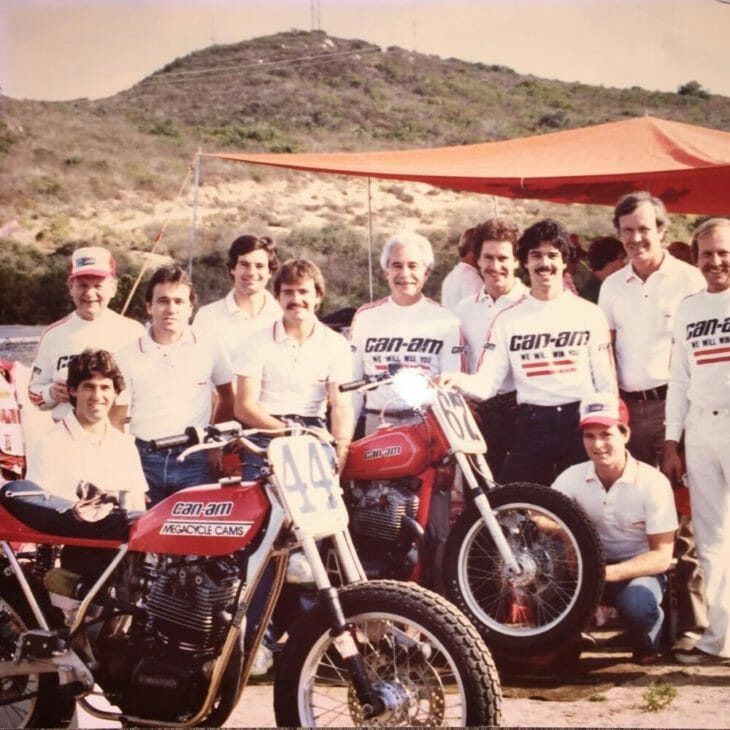 Bubba Shobert (sitting on bike #67) rode a Can-Am-powered Wood racing bike built by Ron Wood (to the right of Shobert).
Bubba Shobert (sitting on bike #67) rode a Can-Am-powered Wood racing bike built by Ron Wood (to the right of Shobert).
The big-tube was a success. Rob Morrison rode the bike to the Ascot season title in ’74. Morrison earned a Norton factory ride for his performance and Wood brought in Alex “Jorgy” Jorgensen to replace him. It was a seamless transition. Like Morrison before him, Jorgy took the Ascot track title in 1975 and ’76.
While the Ascot races proved fruitful, the one thing that eluded Wood was a win at the national level. The problem for Wood and his crew, was keeping the Norton engine reliable enough, meant they could get about 78 horsepower with a newer short-stroke motor. Anything more than that and the engines became grenades. If he couldn’t get anymore power, Wood knew his only hope of running with the factory Harleys and Yamahas was to make his bike lighter. That prompted the third generation Norton that Wood called “The Lightweight”. Amazingly, Wood managed to get his racing Norton down to 268 pounds, about 40 pounds lighter than a Harley XR750.
With the lightweight Jorgensen began being a more consistent threat at the nationals. Finally, everything fell into place at the Ascot AMA Grand National in May of 1978. Besides the ultra-light weight of the Norton, Wood made a last-minute, odd-ball tire selection putting a Carlisle Arrow on the rear. Wood recalled, “Jorgy didn’t think it was a good idea, but the way the track surface was that night, I figured it had to work.”
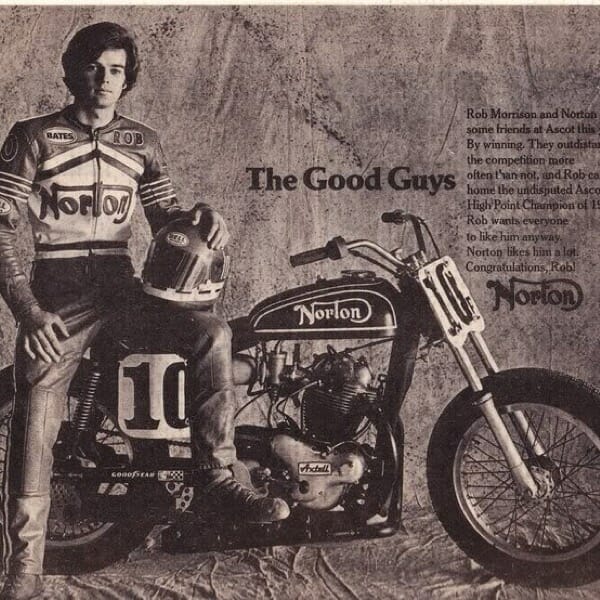 Ron Wood’s first major success came when Rob Morrison rode his machine to the Ascot Park season title in ’74.
Ron Wood’s first major success came when Rob Morrison rode his machine to the Ascot Park season title in ’74.
Wood’s call was brilliant. Jorgy dominated the national that night. It was a breakthrough win that solidified Wood’s reputation as one of the leading builders in the country. It proved to be the final national ever won by a Norton.
Wood went on to design the state-of-the-art short track machine with the Wood-Rotax. The bike was so dominant after being launched in the 1983, that the AMA 600cc National Dirt Track class practically became a Wood-Rotax spec class. It was so good that Harley-Davidson licensed the right to use the Wood-Rotax, re-badged and painted orange and black and called a Harley-Davidson.
“That was one of the proudest moments when dad and his team were converting those bikes into Harley-Davidsons,” said Ron Junior. “There are pictures that have never been published of my dad with the Wood-Rotax in various stages being made into a Harley. He had a huge smile on his face.”
Wood even branched out into road racing in the 1980s with the building of the Wood-Rotax SJ676.
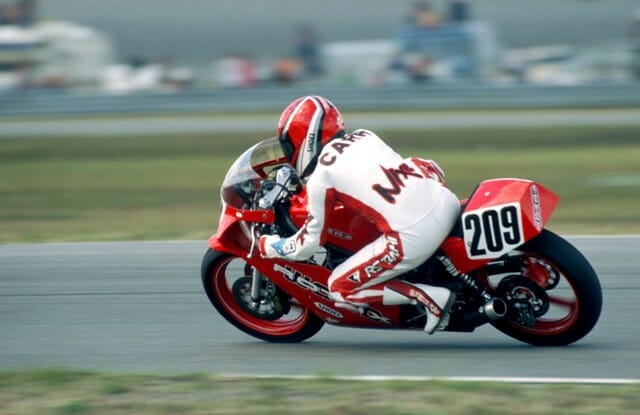 Chris Carr racing the Ron Wood Racing/Hobie Sportswear Wood-Rotax in the 1987 Daytona International Lightweight race. (Larry Lawrence photo)
Chris Carr racing the Ron Wood Racing/Hobie Sportswear Wood-Rotax in the 1987 Daytona International Lightweight race. (Larry Lawrence photo)
But ultimately Wood’s first love was flat track and he continued for the rest of his life building his unique creations. One of his later bikes was a BMW-based flat tracker. Wood finally seemed to hit a wall for years with the development of that bike, but then, with Dalton Gauthier at the controls, the Wood BMW finally won the American Flat Track AFT2 National at the Arizona Mile in 2016.
Looking at an 87-year-old Wood standing beside Gauthier on the podium that day in Phoenix, his trademark smile was beaming ear-to-ear. Ron was in his element and loved every minute of it.